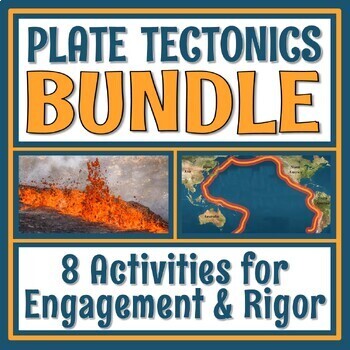Plate Tectonics Activity BUNDLE 8 NGSS Earth Science Activities
- Zip
What educators are saying
Products in this Bundle (6)
showing 1-5 of 6 products
Bonus
Also included in
- Never search for "something to do tomorrow" ever again! This bundle contains PRINT AND GO lessons, NO PREP activities, LOW PREP labs, and ENGAGING articles to supplement and thoroughly enhance an Earth and space science course. Every included resource is easy to implement, standards-based, and high-Price $399.99Original Price $639.06Save $239.07
Description
SAVE 30% and get 8 NO PREP activities to add ENGAGEMENT and NGSS RIGOR to your Plate Tectonics Unit! Students will learn more about plate movement, seafloor spreading, the Ring of Fire, and other plate tectonics topics.
This bundle includes the following resources:
- Graphing Evidence of Sea Floor Spreading Activity
- Plot the Ring of Fire Mapping Activity
- Hawaiian Hot Spot Activity
- Convection Diagram Coloring
- Mapping the Mid-Atlantic Ridge
- Create a Plate Movement Flip Book
- Plate Boundaries Game (FREE BONUS)
- Engaging Alfred Wegener Continental Drift Activity (FREE BONUS)
INDIVIDUAL DESCRIPTIONS:
Graphing Seafloor Spreading: Nails home EVIDENCE that the seafloor near the mid-Atlantic ridge is newer than the seafloor near the continents. In this activity, students will:
- Color-code a diagram of the seafloor and mid-Atlantic ridge based on the age of the rock.
- Measure how far each "band" of the seafloor is from the ridge.
- Graph the relationship between the age of the seafloor rock and the distance from the mid-Atlantic ridge.
- Answer follow-up questions that help students conclude that the seafloor near the mid-Atlantic ridge is newer than the seafloor near the continents.
Plot the Ring of Fire Activity: Students plot the location of the Ring of Fire using locations of REAL earthquakes and volcanoes. In this activity, students will:
- "Work up" the World Map by adding continent labels and identifying the equator and prime meridian. (You may want to lead them through this.)
- Plot earthquakes and volcanoes on the World Map in different colors. The coordinates effectively show the pattern of the Ring of Fire.
- Answer follow-up analysis questions.
Create a Plate Movement Flip Book: In this activity students will:
- Color and cut out the provided picture boxes.
- Staple the picture boxes to create a "flip book" type project that shows plate movement over millions of years.
Mapping the Mid-Atlantic Ridge: In this activity, students will:
- Read background information about how scientists use sonar to measure the depth of the ocean.
- Graph longitude and ocean depth data on a provided graph. The graph creates a "side profile" of the Atlantic ocean floor. This reveals the mid-ocean ridge!
- Add labels to the graph by coloring the Earth and the ocean and labeling the mid-Atlantic ridge and other features.
- Answer questions that review seafloor spreading and continental drift.
Hawaiian Hot Spot Activity: In this activity, students will:
- Read a brief introduction to hot spots.
- Measure the distance between the Hawaiian Islands in the diagram.
- Calculate the speed of plate movement. The worksheet leads students step-by-step through simple calculations.
- Graph the age of the islands (bar graph).
- Answer analysis questions.
Convection Diagram Coloring: Students color a diagram of convection in the mantle - but there's more to it! Students must also answer analysis questions about the diagram once they're finished coloring it.
Alfred Wegener Continental Drift Activity (FREE BONUS): Quick, fun, and engaging continental drift activity! Students read several negative quotes from Alfred Wegener's contemporaries - people who believed that his theory of continental drift was wrong. Students then use their own understanding of the evidence for continental drift to come up with their own fun quotes to support him!
Plate Boundaries Game (FREE BONUS): Review plate boundaries in a simple game that mimics "Rock, Paper, Scissors". Kids already know how to play! In this quick but engaging activity, students play a game similar to "Rock, Paper, Scissors" with boundary types, but the loser of each round has to state a fact about their boundary type.
Teacher Notes:
- Answer keys included.
- Please note: these PDF resources are not editable.
⭐⭐⭐ Click here to get 5 FREE EARTH & SPACE SCIENCE lessons! ⭐⭐⭐






